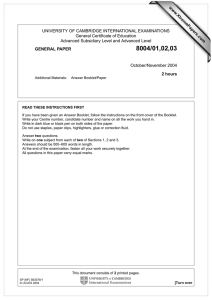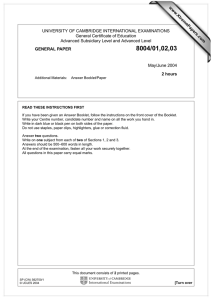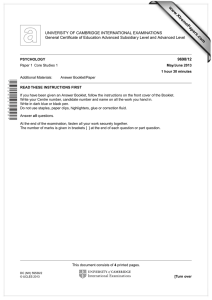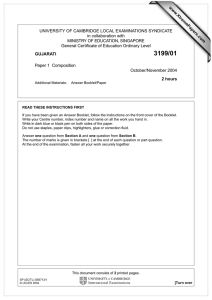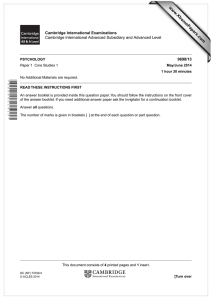www.XtremePapers.com Cambridge International Examinations 9698/12 Cambridge International Advanced Subsidiary and Advanced Level
advertisement
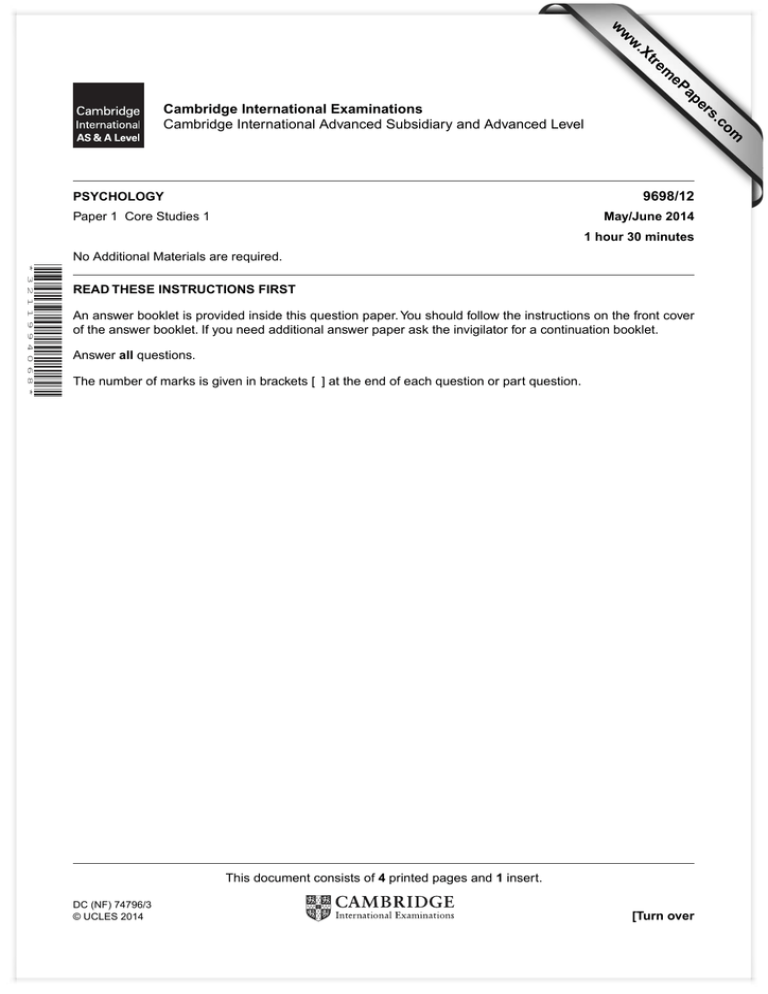
w w ap eP m e tr .X w om .c s er Cambridge International Examinations Cambridge International Advanced Subsidiary and Advanced Level 9698/12 PSYCHOLOGY Paper 1 Core Studies 1 May/June 2014 1 hour 30 minutes No Additional Materials are required. * 3 2 1 1 9 9 4 0 6 8 * READ THESE INSTRUCTIONS FIRST An answer booklet is provided inside this question paper. You should follow the instructions on the front cover of the answer booklet. If you need additional answer paper ask the invigilator for a continuation booklet. Answer all questions. The number of marks is given in brackets [ ] at the end of each question or part question. This document consists of 4 printed pages and 1 insert. DC (NF) 74796/3 © UCLES 2014 [Turn over 2 Section A (60 marks) Answer all questions in this section. 1 From the study by Mann et al. (lying): (a) Give two examples of crimes of which the suspects were accused. [2] (b) Describe what the researchers did to be sure that the sections of video they were using from the suspects were definitely lies or truths. [2] 2 In the study by Loftus and Pickrell, they gave an example of the false event presented to one participant, a 20-year-old Vietnamese-American woman. Describe this false event. [4] 3 In the study by Baron-Cohen et al., they suggested that one problem with the original eyes test was that it suffered from a ceiling effect. 4 5 (a) Explain what is meant by a ‘ceiling effect’. [2] (b) Suggest why a ceiling effect is a problem in this study. [2] In the study by Milgram (obedience), verbal prods were used. (a) Describe two of the verbal prods. [2] (b) Suggest why these prods followed a sequence. [2] From the study by Haney, Banks and Zimbardo (prison simulation): (a) Describe one physical aspect of the prison. [2] (b) What was the least frequent form of behaviour seen during the experiment and how many times was it seen? [2] 6 The participants (boys) in study 1 by Tajfel (intergroup categorisation) estimated numbers of dots and were then divided into groups randomly. However, the boys were told two possible ‘reasons’ for the way they had been divided into groups. (a) Describe one of these ‘reasons’. [2] (b) Explain why it was necessary to deceive the boys about the way they had been grouped. [2] 7 In the study by Freud he describes little Hans’s ‘grandaddy’ fantasy about Hans having his own children. (a) Describe this fantasy. [2] (b) Explain how Freud related this fantasy to the resolution of the Oedipus complex. [2] © UCLES 2014 9698/12/M/J/14 3 8 9 Nelson investigated children’s morals. (a) Name the research method used in the studies by Nelson and justify your answer. [2] (b) Describe the practice trials the children had before the main study. [2] In the study by Dement and Kleitman (sleep and dreaming), participants were awoken by a loud doorbell. (a) Describe what the participants were then expected to do. [2] (b) Explain why it was important that the doorbell was loud. [2] 10 In the study by Maguire et al. (taxi drivers), PET scans were taken during a baseline task for comparison with the PET scans taken during experimental tasks. (a) Describe the baseline task. [2] (b) Explain how the baseline task acted as a control. [2] 11 In the study by Demattè et al., facial stimuli of different levels of attractiveness were used. (a) Describe the stimulus materials (the faces). [2] (b) A within-participants (repeated measures) design was used to test level of attractiveness. Explain why this design was chosen. [2] 12 In the study by Rosenhan (sane in insane places), the pseudo-patients lied when they claimed to be hearing voices. (a) What other lies did they tell during their appointment at the hospital? [2] (b) Suggest why it was important that the pseudo-patients told the lies you have described in part (a). [2] 13 In the study by Thigpen and Cleckley (multiple personality disorder), before the researchers were aware of Eve Black, Eve White reported hearing a voice in her head. (a) What suggested that this was not a symptom of a schizoid or psychotic disorder? [2] (b) With regard to seeking social company, how did Eve Black’s behaviour differ from Eve White’s behaviour? [2] 14 Billington et al. (empathising and systemising) used the forced-choice Embedded Figures Test (FC-EFT). (a) Describe the FC-EFT. [2] (b) What did the results of the FC-EFT show? [2] 15 From the study by Veale and Riley (mirror gazing) describe two ways in which the body dysmorphic disorder (BDD) patients avoided mirrors. [4] © UCLES 2014 9698/12/M/J/14 [Turn over 4 Section B (20 marks) Answer both questions in this section. 16 Use one of the studies listed below to evaluate the use of snapshot studies in psychology. Piliavin et al. (subway Samaritans) Bandura et al. (aggression) Schachter and Singer (emotion) [10] 17 Discuss the strengths and weaknesses of the developmental approach to psychology using one of the studies listed below. Langlois et al. (infant facial preference) Nelson (children’s morals) Held and Hein (kitten carousel) [10] Permission to reproduce items where third-party owned material protected by copyright is included has been sought and cleared where possible. Every reasonable effort has been made by the publisher (UCLES) to trace copyright holders, but if any items requiring clearance have unwittingly been included, the publisher will be pleased to make amends at the earliest possible opportunity. Cambridge International Examinations is part of the Cambridge Assessment Group. Cambridge Assessment is the brand name of University of Cambridge Local Examinations Syndicate (UCLES), which is itself a department of the University of Cambridge. © UCLES 2014 9698/12/M/J/14



